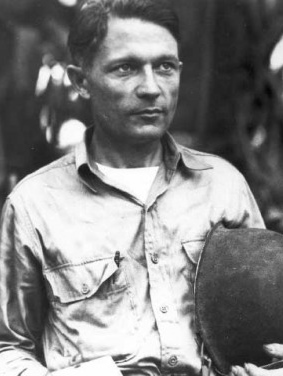TWEED-GEORGE
GEORGE RAY TWEED

LT

HIS SURVIVAL IS CONSIDERED ONE OF
THE GREATEST FEATS IN WAR HISTORY
RM1 George Ray Tweed was assigned to Radio Agana, Guam, when the Japanese invaded on December 10, 1941. Tweed arrived on Guam in August 1939 and his family was evacuated from the island in October 1941 due to the possibility of war with Japan. When a vastly superior Japanese force landed on Guam the meager U.S. forces were forced to surrender as their commander described the situation as “utterly helpless.” In the confusion of the situation, Tweed and five other Navy men managed to slip into the Guam jungle rather than become prisoners of war. Soon the Japanese became aware of rumors concerning the Americans hiding in the jungle and began an intense campaign to locate them. Within several weeks the six men split into smaller groups so they could travel more easily without leaving tracks for the Japanese to follow. Soon Tweed was by himself and with the help of friendly natives managed to elude capture for two years and seven months, during which time the other five men were all captured and executed. While evading the Japanese, Tweed frequently subsisted on insects and plants, studied algebra, played solitaire, made shoes for the families watching over him, and more importantly, managed to repair a radio and obtain radio news from U.S. sources which he published for several months in an underground newsletter, the “GUAM EAGLE,” using an old typewriter and carbon paper. Although the Japanese tortured and executed local natives suspected of helping the missing Americans, Tweed was sheltered in many locations by natives who said they did not want Tweed to surrender as his presence was a symbol of hope and renewed their faith that the Americans would return to retake the island.
On July 10, 1944, Tweed spotted American destroyers cruising along the coastline and managed to signal them from a nearby hill using makeshift semaphore flags and a 3-inch mirror stating that he had valuable information for them. A boat from the USS MCCALL was sent to cautiously investigate and on nearing the beach, Tweed swam to the boat and after 3l-months he was free. He was able to furnish valuable intelligence concerning Japanese fortifications and details concerning the estimated 18,000 Japanese troops on the island. For his heroism, Tweed was awarded the Legion Of Merit and promoted to Chief Radioman. He returned to Guam in 1945, bringing a Chevrolet sedan as a gift from the president of General Motors to one of the natives who had sheltered him. Tweed retired from the Navy in 1948 as a Lieutenant and not long after retiring he published a book entitled, “Robinson Crusoe, USN.” Sadly, he died in an automobile accident in 1989 and was buried at Eagle Point National Cemetery in Oregon. His story was also told by a movie in 1962 entitled, "No Man Is An Island."
Tweed’s survival effort has been described as one of the greatest feats in war history. The Navy officially reported that he was “missing in action and presumed dead.” With a bounty of 1,000-yen posted for his capture the Japanese were determined to locate him but never did although they often sent out 50-man patrols seeking him and reported at war’s end that 30,000-man days were spent looking for the elusive "Yankee American." When Guam was recaptured in 1944 there were approximately 18,000 Japanese troops on the island and Tweed was the only U.S. survivor who remained on the island during the Japanese occupation.
LEGION OF MERIT WITH COMBAT “V’ CITATION
The President of the United States of America takes pleasure in presenting the Legion of Merit with Combat "V" to Radio Electrician George Ray Tweed, United States Navy, for exceptionally meritorious conduct in the performance of outstanding services to the Government of the United States while isolated on Guam following the seizure of that island by enemy Japanese forces on 10 December 1941, until rescued by an American Destroyer during the bombardment by our surface and aerial forces on 10 July 1944. Courageous and resourceful under relentless stalking by the Japanese, Radio Electrician Tweed succeeded in escaping capture and, with the aid of friendly and loyal natives managed not only to subsist during this prolonged, grueling period but to obtain much valuable information concerning the Japanese occupation of the Island. Ingeniously attracting the attention of an American Destroyer operating two miles off shore on 10 July, he subsequently signaled messages by semaphore, revealing information of an undamaged hostile battery of six-inch guns concealed at Point Adelup. After being rescued by our warship, Radio Electrician Tweed turned over a detailed log on enemy movements, troop concentrations, the results of our bombardment on hostile objectives beginning 11 June, and Japanese preparations to repel an amphibious landing, thereby making a vital contribution to the recapture of this strategic American possession.
Submitted by CDR Roy A. Mosteller, USNR (Ret)

